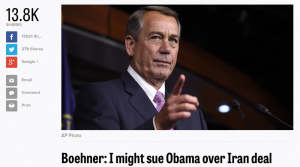Today, so much of the President’s time and energy are focused on international affairs. Not only does the global environment demand the President’s attention but he possesses more sway over the United State’s foreign policy than any other person or branch of the United States. However, this was not always so or at least foreseen. Throughout the drafting of the Constitution, members of the Convention focused the vast majority of their time and energy on outlining the new government’s structure and function concerning internal politics. In Plain, Honest Men, historian and author Richard Beeman only touches upon the treaty a handful of times.
Nevertheless, these sections carry a large importance and expose constitutional concepts that politicians struggle over today: who has the power to structure the United States’ foreign policy. In Article II, section 2 the Constitution gives the President the “Power, by and with the Advice and Consent of the Senate, to make Treaties, provided two thirds of the Senators present concur.” Beeman outlines how this format spawned from the constant concern over the division of power among the different branches of government.
In reality, the words of Article II, section 2 give Congress the real power and sway over treaty making as the President is just their agent of negotiation. Gaining two thirds of Congress’ support is very difficult. Furthermore, the Constitution divides other international duties between the President and Congress. The President is the Command in Chief but only Congress has the authority to raise an Army and declare war. However, Beeman sheds light on the fact that while the Constitution divides power on the ability to declare war and create a treaty it provides little information about the everyday roles of the branches of government in actually conducting either war or foreign policy. ((Richard Beeman, Plain, Honest Men: The Making of the American Constitution, (New York, Random House, 2009), 349.)) One thing is clear though, the Founders were concerned about effectives dividing power between the Executive and Congressional Branches without limiting the new government’s ability to operate effectively.
Fast forward to the present and one cannot help but wonder what happened. Today, the President is the most influential and powerful agent in constructing the United States’ foreign policy. By and large, executive agreements have replaced formal treaties as the means to constructing binding international agreements with other nations. Executive agreements, unlike treaties, do not need the Senate’s approval, giving the President near unilateral power to constuct international law. Today, this shift – the concentration of power under the President – still draws widespread criticism. Earlier this summer, the Iran Nuclear Deal infuriated members of Congress who felt that President Obama bypassed the his Constitutional obligations.
Speaker of the House John Boehner wanted to sue President Obama over the Iran Nuclear Deal which he viewed as “worse than anything [he] could’ve ever imagined.” Speaker Boehner’s sentiments can be difficult to simpathize with. Since World War II, formal treaties have paled in comparison to the number of executive agreements made between the President and other heads of states.
Just how did this shift in power occur? In the epilogue of Plain, Honest Men, Beeman writes about the political troubles plaguing the United States just years after the creation of the Constitution. These problems emerged as a result of tense international developments. I am very interested in researching just how the ambiguity of the Constitution facilitated the concentration of international power under the President.

